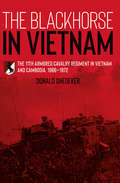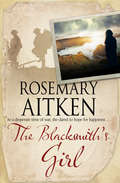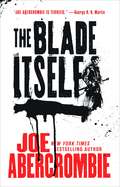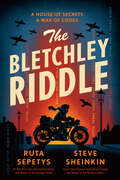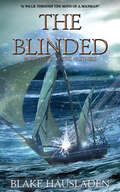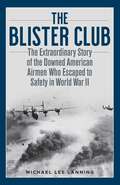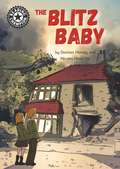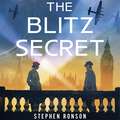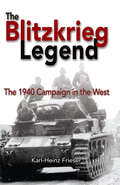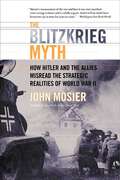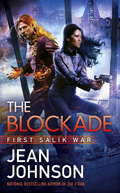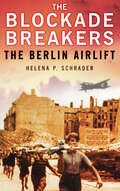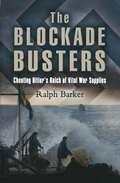- Table View
- List View
The Blackhorse in Vietnam: The 11th Armored Cavalry Regiment in Vietnam and Cambodia, 1966–1972
by Donald SnedekerThis military history chronicles the combat operations of the Blackhorse Regiment, which paved the way for armored cavalry tactics in the Vietnam War. South Vietnam, September 1966. When the 11th Armored Cavalry Regiment came ashore at Vung Tau, it faced a number of challenges. In addition to the threat of the Viet Cong and the North Vietnamese Army, the terrain and weather posed their own dangers, adversely affecting the use of bulletproof vehicles and helicopters. The dearth of doctrine and tactics for the employment of armored cavalry in a counterinsurgency was equally challenging—especially during pre-deployment training and initial combat operations. But despite all this, the leaders of Blackhorse Regiment found a way to accomplish their mission. Within a year of their arrival in Vietnam, Blackhorse troopers overcame ambushes that featured anti-tank weapons, numerous landmines, and coordinated assaults. They not only defeated an enemy division twice their size, but also demonstrated how to succeed while operating on and off the roads, in the jungle, and during both the wet and dry seasons. By the spring of 1967, army leaders were beginning to realize the value of troops stationed in Vietnam. And with the Blackhorse Regiment leading the way, armor came to be considered an essential part of the combat team. Written by a Blackhorse veteran, this regiment history features firsthand accounts from soldiers who served in Vietnam and Cambodia.
The Blackout in Britain and Germany, 1939–1945
by Marc WiggamThis book is the first major study of the blackout in the Second World War. Developing a comparative history of this system of civil defense in Britain and Germany, it begins by exploring how the blackout was planned for in both countries, and how the threat of aerial bombing framed its development. It then examines how well the blackout was adhered to, paying particular regard to the tension between its military value and the difficulties it caused civilians. The book then moves on to discuss how the blackout undermined the perception of security on the home front, especially for women. The final chapter examines the impact of the blackout on industry and transport. Arguing that the blackout formed an integral part in mobilising and legitimating British and German wartime discourses of community, fairness and morality, the book explores its profound impact on both countries.
The Blackshirts’ Dictatorship: Armed Squads, Political Violence, and the Consolidation of Mussolini’s Regime (Routledge Studies in Fascism and the Far Right)
by Matteo MillanOn October 1922 Mussolini became head of the Italian government, a situation that would last for twenty years. That power was obtained was largely due to the widespread violence perpetrated by blackshirts throughout Italy (squadristi). Violence however did not end. Old and new blackshirts played a major role in making Italy a fascist country. Contrary to the claims of many scholars that have depicted blackshirts after the March on Rome only as troublemakers for Mussolini, the book shows that they played a crucial role in establishing a full and totalitarian dictatorship. Squadristi carried out processes of fascistisation, crushed opponents and convinced bystanders and dubious people, consolidating fascist power in many aspects of social, political and even intimate life. By resorting to new archives, a long chronology and a focus on individual perspectives, this book gives voice to the perpetrators of fascist violence and offers new insights into the lives of squadristi throughout the dictatorship, outlining their beliefs, outlooks and expectations. The book shows that post-1922 squadrismo was not a side effect of Fascism's twenty-year history. On the contrary, violence represents one of the essential components of any definition of Italian Fascism.
The Blacksmith's Girl: A World War I Cornish Romance
by Rosemary AitkenOn the windswept shores of Cornwall, two heartsick women find an uncommon bond in this WWI historical romance by the author of Flowers for Miss Pengelly. Cornwall, 1916. Verity Tregorran, one of the local blacksmith’s nine daughters, is finding it hard to hide her long-abiding love for Ned Chegwidden, the boy next door, now serving in the trenches of World War I. But if her parents knew of Verity’s attachment to someone outside the family’s strict Christian sect, they would be horrified. Loitering on the coastal path one evening, Verity witnesses something suspicious on the cliffs which causes her to fear the involvement of German spies. There’s only one person she can turn to: Effie Dawes, wife of the local police constable, who is now fighting overseas himself. Effie meanwhile has a tragedy of her own to face, as a scandal threatens to rock Verity’s family. But the two unlikely friends remain determined in their efforts to discover what really happened on the cliffs.
The Blade Itself (The First Law Trilogy #1)
by Joe AbercrombieThe first novel in the First Law Trilogy and debut fantasy novel from New York Times bestseller, Joe Abercrombie.Logen Ninefingers, infamous barbarian, has finally run out of luck. Caught in one feud too many, he's on the verge of becoming a dead barbarian -- leaving nothing behind him but bad songs, dead friends, and a lot of happy enemies. Nobleman, dashing officer, and paragon of selfishness, Captain Jezal dan Luthar has nothing more dangerous in mind than fleecing his friends at cards and dreaming of glory in the fencing circle. But war is brewing, and on the battlefields of the frozen North they fight by altogether bloodier rules. Inquisitor Glokta, cripple turned torturer, would like nothing better than to see Jezal come home in a box. But then Glokta hates everyone: cutting treason out of the Union one confession at a time leaves little room for friendship. His latest trail of corpses may lead him right to the rotten heart of government, if he can stay alive long enough to follow it. Enter the wizard, Bayaz. A bald old man with a terrible temper and a pathetic assistant, he could be the First of the Magi, he could be a spectacular fraud, but whatever he is, he's about to make the lives of Logen, Jezal, and Glokta a whole lot more difficult. Murderous conspiracies rise to the surface, old scores are ready to be settled, and the line between hero and villain is sharp enough to draw blood. Unpredictable, compelling, wickedly funny, and packed with unforgettable characters, The Blade Itself is noir fantasy with a real cutting edge.
The Bleeding Wound: The Soviet War in Afghanistan and the Collapse of the Soviet System (Cold War International History Project)
by Yaacov Ro'iBy the mid-1980s, public opinion in the USSR had begun to turn against Soviet involvement in Afghanistan: the Soviet–Afghan War (1979–1989) had become a long, painful, and unwinnable conflict, one that Mikhail Gorbachev referred to as a "bleeding wound" in a 1986 speech. The eventual decision to withdraw Soviet troops from Afghanistan created a devastating ripple effect within Soviet society that, this book argues, became a major factor in the collapse of the Soviet Union. In this comprehensive survey of the effects of the war on Soviet society and politics, Yaacov Ro'i analyzes the opinions of Soviet citizens on a host of issues connected with the war and documents the systemic change that would occur when Soviet leadership took public opinion into account. The war and the difficulties that the returning veterans faced undermined the self-esteem and prestige of the Soviet armed forces and provided ample ammunition for media correspondents who sought to challenge the norms of the Soviet system. Through extensive analysis of Soviet newspapers and interviews conducted with Soviet war veterans and regular citizens in the early 1990s, Ro'i argues that the effects of the war precipitated processes that would reveal the inbuilt limitations of the Soviet body politic and contribute to the dissolution of the USSR by 1991.
The Bletchley Girls: War, secrecy, love and loss: the women of Bletchley Park tell their story
by Tessa Dunlop'Dunlop is engaging in her personal approach. Her obvious feminine empathy with the venerable ladies she spoke to gives her book an immediacy and intimacy.' Daily Mail 'An in-depth picture of life in Britain's wartime intelligence centre...The result is fascinating, and is made all the more touching by the developing friendships between Dunlop and her interviewees.' Financial Times The women of Bletchley Park have a unique story to tell. Although critical to the success of the project to break the German and Japanese codes in the Second World War, their contribution has been consistently overlooked and undervalued. Through unprecedented access to surviving veterans, this book reveals how life at 'The Park' and its outstations was far removed from the glamorous existence usually portrayed. The women speak vividly of their lives in the 1930s, why they were selected to work in Britain's most secret organisation, and the challenges of re-entry into civilian life. Forbidden to talk about their vital war work, they often found it hard to adjust to the expectations of both their immediate families and society as a whole. By spending time with these fascinating female secret-keepers who are still alive today, Tessa Dunlop captures their extraordinary journeys into an adult world of war, secrecy, love and loss. Through the voices of the women themselves, this is a portrait of life at Bletchley Park beyond the celebrated code-breakers. The Bletchley Girls is the story of the women behind Britain's ability to consistently outsmart the enemy.
The Bletchley Girls: War, secrecy, love and loss: the women of Bletchley Park tell their story (Extraordinary Lives, Extraordinary Stories of World War Two #7)
by Tessa Dunlop'Lively...in giving us the daily details of their lives in the women's own voices Dunlop does them and us a fine service' New Statesman'Dunlop is engaging in her personal approach. Her obvious feminine empathy with the venerable ladies she spoke to gives her book an immediacy and intimacy.' Daily Mail'An in-depth picture of life in Britain's wartime intelligence centre...The result is fascinating, and is made all the more touching by the developing friendships between Dunlop and her interviewees.' Financial TimesThe Bletchley Girls weaves together the lives of fifteen women who were all selected to work in Britain's most secret organisation - Bletchley Park. It is their story, told in their voices; Tessa met and talked to 15 veterans, often visiting them several times. Firm friendships were made as their epic journey unfolded on paper.The scale of female involvement in Britain during the Second World War wasn't matched in any other country. From 8 million working women just over 7000 were hand-picked to work at Bletchley Park and its outstations. There had always been girls at the Park but soon they outnumbered the men three to one.A refugee from Belgium, a Scottish debutante, a Jewish 14-year-old, and a factory worker from Northamptonshire - the Bletchley Girls confound stereotypes. But they all have one common bond, the war and their highly confidential part in it. In the middle of the night, hunched over meaningless pieces of paper, tending mind-blowing machines, sitting listening for hours on end, theirs was invariably confusing, monotonous and meticulous work, about which they could not breathe a word.By meeting and talking to these fascinating female secret-keepers who are still alive today, Tessa Dunlop captures their extraordinary journeys into an adult world of war, secrecy, love and loss. Through the voices of the women themselves, this is a portrait of life at Bletchley Park beyond the celebrated code-breakers, it's the story of the girls behind Britain's ability to consistently out-smart the enemy, and an insight into the women they have become.
The Bletchley Girls: War, secrecy, love and loss: the women of Bletchley Park tell their story (Extraordinary Lives, Extraordinary Stories of World War Two #7)
by Tessa Dunlop'Lively...in giving us the daily details of their lives in the women's own voices Dunlop does them and us a fine service' New Statesman'Dunlop is engaging in her personal approach. Her obvious feminine empathy with the venerable ladies she spoke to gives her book an immediacy and intimacy.' Daily Mail'An in-depth picture of life in Britain's wartime intelligence centre...The result is fascinating, and is made all the more touching by the developing friendships between Dunlop and her interviewees.' Financial TimesThe Bletchley Girls weaves together the lives of fifteen women who were all selected to work in Britain's most secret organisation - Bletchley Park. It is their story, told in their voices; Tessa met and talked to 15 veterans, often visiting them several times. Firm friendships were made as their epic journey unfolded on paper.The scale of female involvement in Britain during the Second World War wasn't matched in any other country. From 8 million working women just over 7000 were hand-picked to work at Bletchley Park and its outstations. There had always been girls at the Park but soon they outnumbered the men three to one.A refugee from Belgium, a Scottish debutante, a Jewish 14-year-old, and a factory worker from Northamptonshire - the Bletchley Girls confound stereotypes. But they all have one common bond, the war and their highly confidential part in it. In the middle of the night, hunched over meaningless pieces of paper, tending mind-blowing machines, sitting listening for hours on end, theirs was invariably confusing, monotonous and meticulous work, about which they could not breathe a word.By meeting and talking to these fascinating female secret-keepers who are still alive today, Tessa Dunlop captures their extraordinary journeys into an adult world of war, secrecy, love and loss. Through the voices of the women themselves, this is a portrait of life at Bletchley Park beyond the celebrated code-breakers, it's the story of the girls behind Britain's ability to consistently out-smart the enemy, and an insight into the women they have become.(P)2016 Hodder & Stoughton
The Bletchley Riddle
by Ruta Sepetys Steve SheinkinNEW YORK TIMES BESTSELLER • A thrilling mystery and collaboration between award-winning and bestselling authors Ruta Sepetys and Steve Sheinkin! This historical adventure follows two siblings at Bletchley Park, the home of WWII codebreakers, as they try to unravel a mystery surrounding their mother&’s disappearance."Break out your Enigma machines! Sepetys and Sheinkin have written a thrilling World War II code-breaking adventure filled with ciphers, secrets, and spies."—Alan Gratz, New York Times bestselling author of RefugeeRemember, you are bound by the Official Secrets Act…Summer, 1940. Nineteen-year-old Jakob Novis and his quirky younger sister, Lizzie, share a love of riddles and puzzles. And now they&’re living inside of one. The quarrelsome siblings find themselves amid one of the greatest secrets of World War II—Britain&’s eccentric codebreaking factory at Bletchley Park. As Jakob joins Bletchley&’s top minds to crack the Nazi's Enigma cipher, fourteen-year-old Lizzie embarks on a mission to solve the mysterious disappearance of their mother.The Battle of Britain rages and Hitler&’s invasion creeps closer. And at the same time, baffling messages and codes arrive on their doorstep while a menacing inspector lurks outside the gates of the Bletchley mansion. Are the messages truly for them, or are they a trap? Could the riddles of Enigma and their mother's disappearance be somehow connected? Jakob and Lizzie must find a way to work together as they race to decipher clues that unravel a shocking puzzle that presents the ultimate challenge: How long must a secret be kept?
The Blind Man's Garden
by Nadeem AslamThe acclaimed author of The Wasted Vigil now gives us a searing, exquisitely written novel set in Pakistan and Afghanistan in the months following 9/11: a story of war, of one family's losses, and of the simplest, most enduring human impulses. Jeo and Mikal are foster brothers from a small town in Pakistan. Though they were inseparable as children, their adult lives have diverged: Jeo is a dedicated medical student, married a year; Mikal has been a vagabond since he was fifteen, in love with a woman he can't have. But when Jeo decides to sneak across the border into Afghanistan--not to fight with the Taliban against the Americans, rather to help care for wounded civilians--Mikal determines to go with him, to protect him. Yet Jeo's and Mikal's good intentions cannot keep them out of harm's way. As the narrative takes us from the wilds of Afghanistan to the heart of the family left behind--their blind father, haunted by the death of his wife and by the mistakes he may have made in the name of Islam and nationhood; Mikal's beloved brother and sister-in-law; Jeo's wife, whose increasing resolve helps keep the household running, and her superstitious mother--we see all of these lives upended by the turmoil of war. In language as lyrical as it is piercing, in scenes at once beautiful and harrowing, The Blind Man's Garden unflinchingly describes a crucially contemporary yet timeless world in which the line between enemy and ally is indistinct, and where the desire to return home burns brightest of all.
The Blinded (The Vastness #3)
by Blake HausladenThis novella is part three of The Vastness, also available as a collection.The truth of the gods is starting to be revived. Soma overcomes challenges at sea while Barok faces rebellion in Enhedu. Dia has a choice to make that determines everything.“The sea fell away below us and we hurtled into darkness—a vast unending expanse that contained all things and nothing. My perception steadied as though my eyes were healing. All around me threads of great color lashed and warred. We had arrived at the place where it had started—the vastness.” - SikhekThe Vastness is the third and final omnibus collection to the Vesteal Series. The Vastness takes us deep into the capital of Bessradi, following the chaos of Native Silver, where new magic is emerging. Ghosts stir, the ground shakes, and an unknown magic has been unleashed. Blood soon becomes as important as air, and our characters struggle to keep the world balanced.In the end, the war will be over, but which side will win?You can read the trilogy in full volumes, or broken up into five novellas each.The Vestal SeriesA tale of violent magic, intrigue, and statecraft, the Vesteal Series is the story of four souls that are banished beyond the edge of the map to a land of gnarled forests, ancient magic, and the site of a terrible murder. Their struggles to survive will put them at odds with their families, their nation, and the very powers that shaped the world.1. Ghosts in the Yew Novella 1 - Beyond the Edge Novella 2 - Opposing Oaths Novella 3 - Reckless Borders Novella 4 - Bayen's Women Novella 5 - Falling Tides2. Native Silver Novella 1 - Sutler's Road Novella 2 - Forgotten Stairs Novella 3 - Thrall's Wine Novella 4 - Corsair Princess Novella 5 - Tanayon Born 3. The Vastness Novella 1 - Silent Rebellion Novella 2 - The River War Novella 3 - The Blinded Novella 4 - Crimson Valley Novella 5 - Singer's Reward
The Blister Club: The Extraordinary Story of the Downed American Airmen Who Escaped to Safety in World War II
by Michael Lee LanningDuring World War II, some 10,000 American bombers and fighters were shot down over Europe. Of the crews aboard, 26,000 men were killed, while 30,000 survived being shot down only to be captured and made prisoners of war. Against the longest of odds, nearly 3,000 airmen made it to the ground alive, evaded capture, and escaped to safety. These men proudly called themselves the Blister Club.Drawing on tens of thousands of pages of mostly untapped documents in the National Archives, Michael Lee Lanning tells the story of these courageous airmen. They had received escape-and-evasion (E & E) training, and some were lucky enough to land with their E-&-E kits—but all bets were off once they hit the ground. They landed after an air catastrophe. The geography was usually unfamiliar. Civilians might or might not be trustworthy. German soldiers and Gestapo agents hunted down airmen as well as civilians who dared help them. If an airman abandoned his uniform for civilian garb, he forfeited Geneva Convention protections. Most faced the daunting task of escaping on foot across hundreds of miles. The fortunate connected with one of the established escape routes to Spain or Switzerland or across the English Channel, or they hooked up with the underground resistance or friendly civilians. Upon return to friendly lines, these men were often able to provide valuable intelligence about enemy troop dispositions and civilian morale. Many volunteered to fly again even though regulations prohibited it.The Blister Club is history with a punch. With a historian&’s eye, Lanning covers the hows and whys of escape-and-evasion and aerial combat in the European theater, but the book also vividly captures the stories of the airmen who did the escaping and evading, including that of a young pilot named Chuck Yeager, who, during his own escape, aided the French Resistance and helped another downed airman to safety—and then begged to fly again, eventually securing Eisenhower&’s approval to return to the air, where he achieved ace status. Stories of escape are popular, especially those set during World War II, as are stories of the war in the air. Combining both of these, The Blister Club should find an enthusiastic audience.
The Blitz Baby: Independent Reading 15 (Reading Champion #313)
by Damian HarveyDuring a bombing of Plymouth in World War 2, a German plane is shot down near Jenny and Thomas's house. They long to investigate, but they hear something and decide to investigate first. They are soon in grave danger, needing help from the last source they would expect.This first colour chapter book is a perfectly levelled, accessible text for Key stage 2 readers aged 9-10. Reading Champion offers independent reading books for children to practise and reinforce their developing reading skills.Fantastic, original stories are accompanied by engaging artwork and activities to provoke deeper response and encourage writing. Each book has been carefully graded so that it can be matched to a child's reading ability, encouraging reading for pleasure.The Key Stage 2 Reading Champion Books are suggested for use as follows:Independent Reading 11: start of Year 3 or age 7+Independent Reading 12: end of Year 3 or age 7+Independent Reading 13: start of Year 4 or age 8+Independent Reading 14: end of Year 4 or age 8+Independent Reading 15: start of Year 5 or age 9+Independent Reading 16: end of Year 5 or age 9+Independent Reading 17: start of Year 6 or age 10+Independent Reading 18: end of Year 6 or age 10+
The Blitz Girls: A heartwarming and utterly gripping new WW2 series
by Johanna BellA heartwarming and gripping new saga series from the author of The Bobby Girls***Their country needs them. They need each other.August, 1940. The war is raging in Europe, but on the home front conflict still seems far away.Dot, living with her mother-in-law and dreading the day that her thuggish husband comes home on leave, is fighting her own battle to contribute to the war effort. Peggy has found confidence as an Air Raid Precaution Warden, despite the jeers of the men she works with - but beneath her pluck she fears for her close-knit family, scattered by the war. And glamorous Vivian, the former debutante, is running away from her own heart and into danger as a volunteer ambulance driver.Then the bombs begin to fall over London, and all their lives are turned upside down. Thrown together into an unlikely friendship, can the Blitz Girls protect their country - and each other - in the darkest hour?Readers love THE BLITZ GIRLS!'Absolutely loved this book, if you enjoy WW2 stories then this is for you' 5*'I devoured this, it's going to be a great series' 5*'I LOVED this book, every single page from start to finish' 5*'What a wonderful story' 5*'Family saga at the best. I sat up most of the night to finish it' 5*'The sense of strength, camaraderie and friendship was so strong in this' 5****Praise for Johanna Bell:Filled with richly drawn characters that leap from the page, and a plot that's so well researched and well written you will believe you are in the thick of wartime policing, The Bobby Girls is a must-read for all saga fans.' - Fiona Ford, bestselling author of Christmas at Liberty's'I really enjoyed reading about Britain's first female police officers. A lot of research has gone into this book and it's all the richer and more readable for it. An exciting new voice in women's fiction.' - Kate Thompson, bestselling author of Secrets of the Singer Girls'I really did enjoy The Bobby Girls. It has a lovely warm feeling about it and is excellently written.' - Maureen Lee, RNA award-winning author of Dancing in the Dark'A well-researched and interesting story giving a great insight into early women's policing.' - Anna Jacobs, bestselling author of the Ellindale series'Written with warmth and compassion, the novel gives fascinating insights into the lives of three courageous young women.' - Margaret Kaine, RNA award-winning author of Ring of Clay'Johanna Bell has hit the jackpot with this striking WW1 crime story. The author places the focus firmly on the girls' growth into independent members of society in a rapidly changing world. It's a heartening central message conveyed with verve and empathy and remains relevant to today's readers, both young and old.' - Jenny Holmes, author of The Spitfire Girls'This is a story that needed to be told. As a former Special Constable, I love Johanna Bell from the bottom of my heart for giving a voice to the women who first made a way for me and countless others like me - to work as real police officers in the service of our communities.' - Penny Thorpe, author of The Quality Street Girls'A lovely story! The author has researched the era and the theme very well. The characters stood out on the page and through their eyes you are transported back to a different age.' - AnneMarie Brear, author of Beneath a Stormy Sky
The Blitz Girls: A heartwarming and utterly gripping new WW2 series
by Johanna BellA heartwarming and gripping new saga series from the author of The Bobby Girls***Their country needs them. They need each other.August, 1940. The war is raging in Europe, but on the home front conflict still seems far away.Dot, living with her mother-in-law and dreading the day that her thuggish husband comes home on leave, is fighting her own battle to contribute to the war effort. Peggy has found confidence as an Air Raid Precaution Warden, despite the jeers of the men she works with - but beneath her pluck she fears for her close-knit family, scattered by the war. And glamorous Vivian, the former debutante, is running away from her own heart and into danger as a volunteer ambulance driver.Then the bombs begin to fall over London, and all their lives are turned upside down. Thrown together into an unlikely friendship, can the Blitz Girls protect their country - and each other - in the darkest hour?Readers love THE BLITZ GIRLS!'Absolutely loved this book, if you enjoy WW2 stories then this is for you' 5*'I devoured this, it's going to be a great series' 5*'I LOVED this book, every single page from start to finish' 5*'What a wonderful story' 5*'Family saga at the best. I sat up most of the night to finish it' 5*'The sense of strength, camaraderie and friendship was so strong in this' 5****Praise for Johanna Bell:Filled with richly drawn characters that leap from the page, and a plot that's so well researched and well written you will believe you are in the thick of wartime policing, The Bobby Girls is a must-read for all saga fans.' - Fiona Ford, bestselling author of Christmas at Liberty's'I really enjoyed reading about Britain's first female police officers. A lot of research has gone into this book and it's all the richer and more readable for it. An exciting new voice in women's fiction.' - Kate Thompson, bestselling author of Secrets of the Singer Girls'I really did enjoy The Bobby Girls. It has a lovely warm feeling about it and is excellently written.' - Maureen Lee, RNA award-winning author of Dancing in the Dark'A well-researched and interesting story giving a great insight into early women's policing.' - Anna Jacobs, bestselling author of the Ellindale series'Written with warmth and compassion, the novel gives fascinating insights into the lives of three courageous young women.' - Margaret Kaine, RNA award-winning author of Ring of Clay'Johanna Bell has hit the jackpot with this striking WW1 crime story. The author places the focus firmly on the girls' growth into independent members of society in a rapidly changing world. It's a heartening central message conveyed with verve and empathy and remains relevant to today's readers, both young and old.' - Jenny Holmes, author of The Spitfire Girls'This is a story that needed to be told. As a former Special Constable, I love Johanna Bell from the bottom of my heart for giving a voice to the women who first made a way for me and countless others like me - to work as real police officers in the service of our communities.' - Penny Thorpe, author of The Quality Street Girls'A lovely story! The author has researched the era and the theme very well. The characters stood out on the page and through their eyes you are transported back to a different age.' - AnneMarie Brear, author of Beneath a Stormy Sky
The Blitz Girls: Book One in the Blitz Girls Series
by Johanna BellAn uplifting and dramatic new saga series about the women who held the country together in its darkest hour - the heroines of the Blitz. Perfect for fans of Jenny Holmes, Nancy Revell and Margaret Dickinson.A heartwarming and gripping new saga series from the author of The Bobby GirlsTheir country needs them. They need each other.August, 1940. The war is raging in Europe, but on the home front conflict still seems far away.Dot, living with her mother-in-law and dreading the day that her thuggish husband comes home on leave, is fighting her own battle to contribute to the war effort. Peggy has found confidence as an Air Raid Precaution Warden, despite the jeers of the men she works with - but beneath her pluck she fears for her close-knit family, scattered by the war. And glamorous Vivian, the former debutante, is running away from her own heart and into danger as a volunteer ambulance driver.Then the bombs begin to fall over London, and all their lives are turned upside down. Thrown together into an unlikely friendship, can the Blitz Girls protect their country - and each other - in the darkest hour?Praise for Johanna Bell:'I really did enjoy The Bobby Girls. It has a lovely warm feeling about it and is excellently written.' - Maureen Lee, RNA award-winning author of Dancing in the Dark'A well-researched and interesting story giving a great insight into early women's policing.' - Anna Jacobs, bestselling author of the Ellindale series'Written with warmth and compassion, the novel gives fascinating insights into the lives of three courageous young women.' - Margaret Kaine, RNA award-winning author of Ring of Clay'Johanna Bell has hit the jackpot with this striking WW1 crime story. The author places the focus firmly on the girls' growth into independent members of society in a rapidly changing world.' - Jenny Holmes, author of The Spitfire Girls'This is a story that needed to be told. As a former Special Constable, I love Johanna Bell from the bottom of my heart for giving a voice to the women who first made a way for me and countless others like me - to work as real police officers in the service of our communities.' - Penny Thorpe, author of The Quality Street Girls(P) 2023 Hodder & Stoughton Limited
The Blitz Secret: A totally gripping WW2 historical thriller (John Cook)
by Stephen Ronson'I felt like I could smell the smoke and was holding my breath. Pacy and full of action with unpredictable twists the pages were turning non-stop to keep up... A fabulous series with great characters where you feel you are right alongside them through out. Highly recommend' Reader review ⭐⭐⭐⭐⭐London is under attack. Secrets and spies hide in the shadows. Who can you trust when every night could be your last?London, 1940: Farmer John Cook would rather avoid the city at the best of times. But as he watches Nazi bombers passing overhead in the moonlight, he knows he is exactly where he needs to be. A young woman has disappeared during an air raid and Cook links her to a network of spies. As his search continues, he realises more is at stake than he could have imagined...Occupied France: Lady Margaret is playing a dangerous game. To the German high-command she is a valuable prize. To the British, she has become the enemy, unless she can do the impossible: gain the trust of those at the heart of the Nazi war machine and betray their secrets. With the fate of Europe in their hands, will Cook and Margaret make the ultimate sacrifice to keep each other's secrets safe and save innocent lives? Everyone is gripped by The Blitz Secret: 'A tense and twisty ride to the final chapter... A definite book of the year' Reader review ⭐⭐⭐⭐⭐'I loved this book! Highlighting the darker side of wartime London and the Blitz, this story takes the reader through the Blackout, smelly, dirty air raid shelters, criminality, prostitution, gangs and murder... Excellent read- highly recommended!' Reader review ⭐⭐⭐⭐⭐'Another great read in the John Cook series. A fast-paced action book with lots of twists and turns' Reader review ⭐⭐⭐⭐⭐'The descriptions of life in the docklands during these early days of the Blitz bombing are very graphic and realistic. Ronson has clearly researched this in depth and you get a real insight into how people lived and survived this phase of the war... A great novel for those who like mystery and adventure and are interested in WW2 history' Reader review ⭐⭐⭐⭐⭐'Enabled me to smell, see and experience London during the Blitz... The conclusion was brilliant, intriguing and now I can't wait for the next book! Highly recommended!' Reader review ⭐⭐⭐⭐⭐'Ronson brings the history of the Blitz in London to life through detailed research and compelling storytelling. A must read' Joanne Kormylo Readers can't put down the John Cook series by Stephen Ronson:'Thrilling WWII set thriller that has heart-pounding action, but more importantly, a lot of heart... Completely gripping... A narrative that is as taut as piano wire!.. .Not to be missed if you enjoy action-packed historical thrillers' Reader review ⭐⭐⭐⭐⭐'My God, this was great. It left me with a book hangover. I felt like I was there in 1940s England... I learned so much from this book... The writing is really 3D. You really feel like you're there. It's very immersive, and I love the witty humour. John Cook is a wonderful character' Reader review ⭐⭐⭐⭐⭐'A gripping World War Two thriller . . . Every shadow hides a potential threat and the tension never lets up. A must read' Reader review ⭐⭐⭐⭐⭐'Ronson delivers a cracking yarn, convincingly told. John Cook is the Jack Reacher of 1940s Britain' Damien Lewis
The Blitz Secret: A totally gripping WW2 historical thriller (John Cook)
by Stephen RonsonLondon is under attack. Secrets and spies hide in the shadows. Who can you trust when every night could be your last?London, 1940: Farmer John Cook would rather avoid the city at the best of times. But as he watches Nazi bombers passing overhead in the moonlight, he knows he is exactly where he needs to be. A young woman has disappeared during an air raid and Cook links her to a network of spies. As his search continues, he realises more is at stake than he could have imagined...Occupied France: Lady Margaret is playing a dangerous game. To the German high-command she is a valuable prize. To the British, she has become the enemy, unless she can do the impossible: gain the trust of those at the heart of the Nazi war machine and betray their secrets. With the fate of Europe in their hands, will Cook and Margaret make the ultimate sacrifice to keep each other's secrets safe and save innocent lives? Everyone is gripped by Stephen Ronson:'Thrilling WWII set thriller that has heart-pounding action, but more importantly, a lot of heart... Completely gripping... A narrative that is as taut as piano wire!.. .Not to be missed if you enjoy action-packed historical thrillers' Reader review ⭐⭐⭐⭐⭐'My God, this was great. It left me with a book hangover. I felt like I was there in 1940s England... I learned so much from this book... The writing is really 3D. You really feel like you're there. It's very immersive, and I love the witty humour. John Cook is a wonderful character' Reader review ⭐⭐⭐⭐⭐'A gripping World War Two thriller . . . Every shadow hides a potential threat and the tension never lets up. A must read' Reader review ⭐⭐⭐⭐⭐'Ronson delivers a cracking yarn, convincingly told. John Cook is the Jack Reacher of 1940s Britain' Damien Lewis
The Blitzkrieg Legend
by Karl-Heinz FrieserHere, for the first time in English, is an illuminating new German perspective on the decisive Blitzkrieg campaign of 1940. Karl-Heinz Frieser's account provides the definitive explanation for Germany's startling success and the equally surprising and rapid military collapse of France and Britain on the European continent. In a little over a month, Germany decisively defeated the Allies in battle, a task that had not been achieved in four years of brutal fighting during World War I.First published in 1995 as the official German history of the 1940 campaign in the west, the book goes beyond standard explanations to show that German victory was not inevitable and French defeat was not preordained. Contrary to the usual accounts of the campaign, Frieser illustrates that the military systems of both Germany and France were solid and that their campaign planning was sound. The key to victory or defeat, he argues, was the execution of operational plans-both preplanned and ad hoc-amid the eternal Clausewitzian combat factors of friction and the fog of war. Frieser shows why on the eve of the campaign the British and French leaders had good cause to be confident and why many German generals were understandably concerned that disaster was looming for them.This study explodes many of the myths concerning German Blitzkrieg warfare and the planning for the 1940 campaign. A groundbreaking new interpretation of a topic that has long interested students of military history, it is being published in cooperation with the Association of the U.S. Army
The Blitzkrieg Myth: How Hitler and the Allies Misread the Strategic Realities of World War II
by John MosierMany military tactics during World War II were based on the assumption that new technologies would lead to decisive battlefield victories, demoralization of the enemy by intensive bombing, or even a quick surrender. Political and military leaders, Allies and Axis alike, believed that “blitzkrieg” was the best way to victory. But in The Blitzkrieg Myth, John Mosier argues that this was not the case. Mosier examines the major European campaigns, including Germany’s invasion of Poland in the fall of 1939 and the fall of France in 1940, and demonstrates that they were, in fact, not blitzkrieg victories. Mosier asserts that new technologies clashed with the realities of conventional military tactics, and battle outcomes often depended on traditional warfare, in this bold reassessment of the military history of World War II. John Mosier is the author of The Myth of the Great War. He is a professor of English at Loyola University in New Orleans. His background as a military historian dates from his role in developing an interdisciplinary curriculum for the study of the two World Wars, a program funded by the National Endowment for the Humanities. From 1989 to 1992, he edited the New Orleans Review. “Should be valued as essential reading on the great conflict.” — Washington Times
The Blockade
by Jean JohnsonThe national bestselling author of The V'Dan returns to her gripping military sci-fi series set in the same world as Theirs Not to Reason Why. The First Salik War is underway, and the Alliance is losing--their newest allies must find a way to win, or everyone will be slaughtered. Though committed to helping their V'Dan cousins, the Terrans resent how their allies treat them. The V'Dan in turn feel the Terrans are too unseasoned to act independently. And the other nations fear that ending the Salik War means starting a Human Civil War. Even as Imperial Prince Li'eth and Ambassador Jackie MacKenzie struggle to get their peoples to cooperate, they still face an ethical dilemma: How do you stop a ruthless, advanced nation from attacking again and again without slaughtering them in turn?
The Blockade Breakers: The Berlin Airlift
by Helena P SchraderOn 24 June 1948 the Sovient Union abrubtly closed all land and water access to the Western Sectors of Berlin. Over 2 million civilians, dependent on the surrounding territory and the West for food, fuel, and other basic goods, were suddenly cut off from all necessities of life. The Western Allies had the option of withdrawing their garrisons and allowing the Soviet Union to take control of the entire city, or of trying to supply the city by air. Never in history had 2 million people been supplied exclusively by air before. None of the senior military commanders believed it could be done. But the political leadership in London and Washington insisted that it must be done. A withdrawal from Berlin would discredit the West at a critical moment in history, when the Soviet Union was expanding aggressively across Europe. Worse, it would endanger the political stability and economic recovery of all of Europe. So the largest and most ambitious Airlift in history was set in motion. It began without the West really knowing what the Berliners needed in order to survive - much less how much those supplies weighed. It was launched despite a lack of airlift expertise in theatre or a unified command structure, an almost complete absence of aircraft and aircrew resources in Germany and serious inadequacies in airfields and air traffic control. But once it took wing, it flew and turned into something that not even its originators and advocates had ever imagined or expected.
The Blockade Busters: Cheating Hitler's Reich of Vital War Supplies
by Ralph BarkerA detailed history of three British World War II blockade runs to get vital supplies from Sweden past the Germans.The Blockade Busters recounts one of the greatest sea stories of World War II. It is the story of how George Binney, a thirty-nine-year-old civilian working in neutral Sweden when Norway was overrun by the Germans in 1940. He set about running vital cargoes of Swedish ball-bearings and special steels to Britain through the blockaded Skagerrak, where German air strength was dominant and where the Royal Navy dare not trespass. Despite Admiralty gloom and in the face of political objections that were overcome by Binney&’s persistence, five ships carrying a year&’s supply of valuable materials for the expanding British war industries were successfully sailed to Britain in January 1941. The following attempt was not as successful and ended when six ships were sunk or scuttled. But then came the saga of the Little Ships, the motor gunboats flying the Red Duster that operated out of the Humber to and from the Swedish coast in the winter of 1943/44, defying the strengthened German defences and the wrath of severe weather.
The Blocking of Zeebrugge - Operation Z-O 1918
by Giuseppe Rava Stephen PrinceOn the night of 22-23 April 1918 the Royal Navy carried out a raid on the German held ports of Zeebrugge and Ostend - Operation Z-O. Under the cover of clouds and smoke, over 70 ships and an assault force of 1,800 Royal Marines embarked on a daring mission which involved a vicious battle of incredible intensity. However, despite the gallant and courageous efforts of the attackers, 11 of whom were later awarded the Victoria Cross, the raid was only partly successful. Discover the successes and failures of this dramatic raid in this in-depth account, complete with specially commissioned battlescene artwork. The author reveals how despite failure, the raid demonstrated to Germany that Britain was still capable of offensive action, even as its armies were being forced back.
